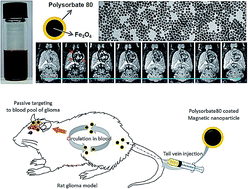T2- and T *2-weighted MRI of rat glioma using polysorbate-coated magnetic nanocrystals as a blood-pool contrast agent
Abstract
In this study, T2- and T*2-weighted imaging potential of polysorbate-coated magnetic nanocrystals (P-MNCs) was investigated as a blood-pool contrast agent using a 9L-rat glioma model after intravenous injection via 3.0T MRI. Magnetic nanocrystals (MNCs, Fe3O4) synthesized by the thermal decomposition method were coated with polysorbate 80 using a nanoemulsion method to generate a water-stable MRI contrast agent. The physical properties and MR imaging capability of P-MNCs were verified. The orthotopic tumor models were established by implanting 9L-rat glioma cells into the rat brain. After tail-vein injection of P-MNCs, T2- and T*2-weighted imaging of tumor sites was performed. Blood clearance and biodistribution studies were also performed. The hydrodynamic diameter of P-MNCs was 10.5 ± 0.8 nm and a spherical magnetic core was confirmed. The r2 value of P-MNCs was calculated to be 114.1 mM−1 s−1. Heterogeneous contrast T2-weighted MRI images of the 9L-rat glioma model were visualized at the tumor site before injecting the MRI contrast agent. In particular, T*2-weighted images demonstrated more obvious signal intensity changes than did T2-weighted images. Neovasculature in the tumor tissue was clearly observed in T*2 images compared with T2-weighted images. The blood half-life of P-MNCs was 2 h and the Fe ion concentration of blood had returned to the baseline after 16 h. Well-tailored P-MNCs can be effectively used as a novel MRI contrast agent for visualizing of vasculatures for solid tumors via T2- and T*2-weighted imaging.


 Please wait while we load your content...
Please wait while we load your content...